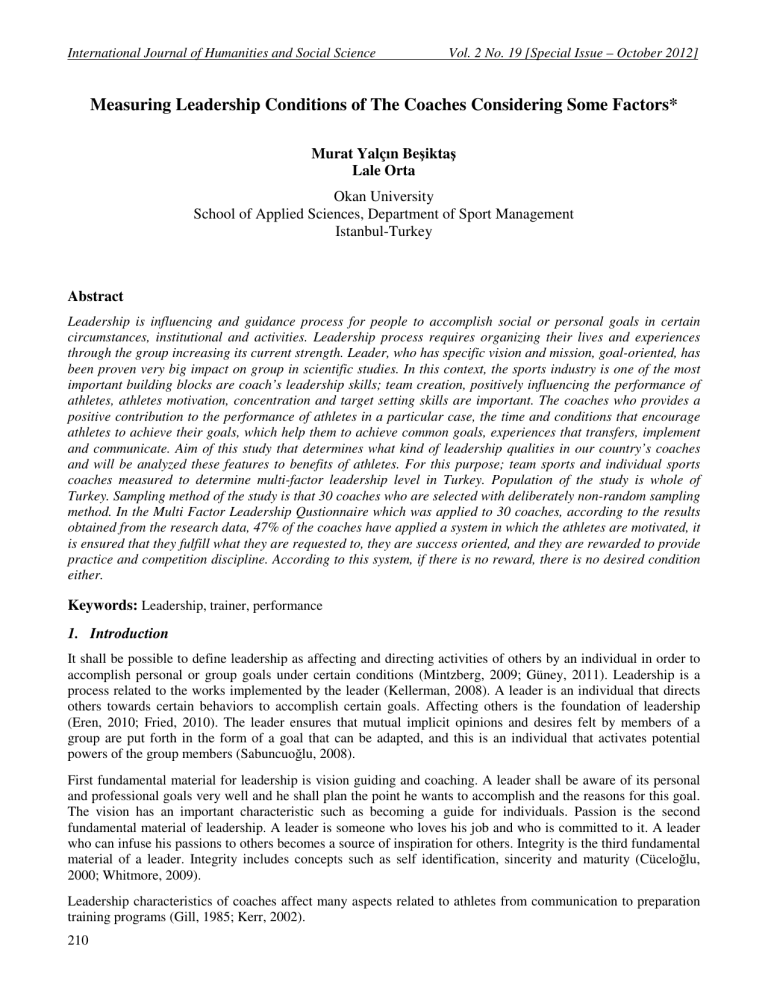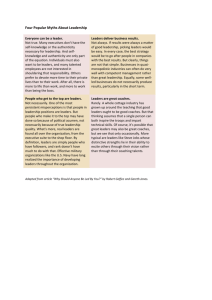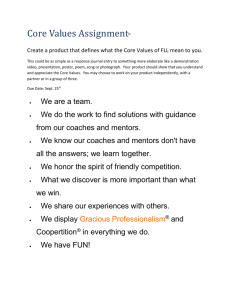Document 10464694

International Journal of Humanities and Social Science Vol. 2 No. 19 [Special Issue – October 2012]
Measuring Leadership Conditions of The Coaches Considering Some Factors*
Murat Yalçın Be
ş
ikta
ş
Lale Orta
Okan University
School of Applied Sciences, Department of Sport Management
Istanbul-Turkey
Abstract
Leadership is influencing and guidance process for people to accomplish social or personal goals in certain circumstances, institutional and activities. Leadership process requires organizing their lives and experiences through the group increasing its current strength. Leader, who has specific vision and mission, goal-oriented, has been proven very big impact on group in scientific studies. In this context, the sports industry is one of the most important building blocks are coach’s leadership skills; team creation, positively influencing the performance of athletes, athletes motivation, concentration and target setting skills are important. The coaches who provides a positive contribution to the performance of athletes in a particular case, the time and conditions that encourage athletes to achieve their goals, which help them to achieve common goals, experiences that transfers, implement and communicate. Aim of this study that determines what kind of leadership qualities in our country’s coaches and will be analyzed these features to benefits of athletes. For this purpose; team sports and individual sports coaches measured to determine multi-factor leadership level in Turkey. Population of the study is whole of
Turkey. Sampling method of the study is that 30 coaches who are selected with deliberately non-random sampling method. In the Multi Factor Leadership Qustionnaire which was applied to 30 coaches, according to the results obtained from the research data, 47% of the coaches have applied a system in which the athletes are motivated, it is ensured that they fulfill what they are requested to, they are success oriented, and they are rewarded to provide practice and competition discipline. According to this system, if there is no reward, there is no desired condition either.
Keywords:
Leadership, trainer, performance
1.
Introduction
It shall be possible to define leadership as affecting and directing activities of others by an individual in order to accomplish personal or group goals under certain conditions (Mintzberg, 2009; Güney, 2011). Leadership is a process related to the works implemented by the leader (Kellerman, 2008). A leader is an individual that directs others towards certain behaviors to accomplish certain goals. Affecting others is the foundation of leadership
(Eren, 2010; Fried, 2010). The leader ensures that mutual implicit opinions and desires felt by members of a group are put forth in the form of a goal that can be adapted, and this is an individual that activates potential powers of the group members (Sabuncuo ğ lu, 2008).
First fundamental material for leadership is vision guiding and coaching. A leader shall be aware of its personal and professional goals very well and he shall plan the point he wants to accomplish and the reasons for this goal.
The vision has an important characteristic such as becoming a guide for individuals. Passion is the second fundamental material of leadership. A leader is someone who loves his job and who is committed to it. A leader who can infuse his passions to others becomes a source of inspiration for others. Integrity is the third fundamental material of a leader. Integrity includes concepts such as self identification, sincerity and maturity (Cücelo ğ lu,
2000; Whitmore, 2009).
Leadership characteristics of coaches affect many aspects related to athletes from communication to preparation training programs (Gill, 1985; Kerr, 2002).
210
The Special Issue on Business and Social Science © Centre for Promoting Ideas, USA www.ijhssnet.com
The following is a list of factors that show positive leadership ability of a coach in sports area:
1To integrate personal objectives and team objectives,
2To ensure a positive communication environment with top, low and same level individuals,
3To ensure that the sportive productivity is increased,
4To successfully represent the team or club,
5To evaluate successes accomplished by athletes with objective scales,
6To use his authority in a balanced form,
7To ensure collaboration and coordination with athletes and lower rank employees when fulfilling duties,
According to the new theories suggested in relation to leadership phenomenon, when modern leadership methods are studied, four fundamentally different leadership methods are identified (Dubrin and Dalglish, 2003; Atkinson et. al. 2010).
1Charismatic Leadership: Charisma is defined as addressing emotions of the individuals surrounding the leader. When this is considered from an organizations aspect, it is defined as a leader's power to influence others, in particular the team related to him, who communicate with him with skills to gain their trust, regard and admiration (Akgemci, 2008; Atkinson et. al. 2010).
2Coach Style Leadership: It is the leader profile in which the leader listens to the members of the group, values their opinions and expectations, shows an objective and leaves it to their discretion to determine the way to accomplish that objective (Atkinson et. al. 2010). A leader who undertakes coaching duty establishes a two sided communication procedure based on trust and mutual understanding with the group members different from a traditional leader. He helps them to identify themselves emotionally and intellectually (Cooper and Sawaf, 1997; Cox, 2007; Fried, 2010; Atkinson et. al. 2010).
3Interactionist Leadership: It is the leadership method in which the relationship between the leader and the group members is based on work (Atkinson et. al. 2010). This kind of leader requires compliance with work standards in the work environment, he aims at duty oriented working to accomplish goals and he displays a behavior in which the individuals are rewarded if they fulfill their duties successfully and they are penalized if they fail to fulfill their duties (Cücelo ğ lu, 2000; Atkinson et. al. 2010).
4Transformist Leadership: This kind of leadership method aims at diversity, it is open for change and it is human oriented (Atkinson et. al. 2010, Eren, 2010). Transformist leaders create and share vision and they constantly communicate with group members and they are individuals who are respected and trusted by group members. Transformist leaders affect the group members in the following three aspects: A) Leader ensures that the members recognize the importance of their performance in helping the organization accomplish success when fulfilling their duties and assignments. B) The leader primarily analysis the potential of the group members, and ensures that they are aware of all that is necessary to increase their personal development, performance and success. C) The leader guides the group members to earn a perspective with respect to the objectives of the organizations excluding their personal goals (Lussier and
Kimball, 2009).
The leadership characteristics shown by leaders will be identified in this study, and the benefits of these characteristics on athletes will be discussed.
2.
Methodology
In this study multi factor leadership characteristics of 30 coaches in individual and team sport fields such as
Swimming, Athleticism, Football, Basketball and Body Building are measured and the types of leaderships shown by them are identified. "Multi Factor Leadership Survey" was used to identify leadership types of the coaches. A survey with 21 five point likert scale was applied. Cronbach Alpha coefficient of this survey, which was developed by Bass, was identified to be 0.95. In this study, efforts were made to identify the leadership methods of the coaches with positive and negative factors and recommendations were provided.
3.
Findings
The Multi Factor Leadership survey determines the type of your leadership. There are 21 questions related to leadership in the survey. Pointing approach of the five point likert scale is as follows: 0 = Absolutely not;
1 = Seldom; 2 = Sometimes; 3 = Frequently; 4 = very Frequently. Questions used in the Multi Factor Leadership
Questionnaire are shown in Table 1.
211
International Journal of Humanities and Social Science Vol. 2 No. 19 [Special Issue – October 2012]
No. Contents of the Questions
Tablo 1. Multifactor Leadership Questionnaire
Scoring
1.
I make others feel good to be around me. 0 1 2 3 4
2.
I express with a few simple words what we could and should do.
3.
I enable others to think about old problems in new ways.
0 1 2 3 4
0 1 2 3 4
4.
I help others develop themselves. 0 1 2 3 4
5.
I tell others what to do if they want to be rewarded for their work.
6.
I am satisfied when others meet agreed-upon standards.
7.
I am content to let others continue working in the same way as always.
8.
Others have complete faith in me.
9.
I provide appealing images about what we can do.
10.
I provide others with new ways of looking at puzzling things.
11.
I let others know how I think they are doing.
12.
I provide recognition/rewards when others reach their goals.
13.
As long as things are working, I do not try to change anything.
14.
Whatever others want to do is O.K. with me.
15.
Others are proud to be associated with me.
0 1 2 3 4
0 1 2 3 4
0 1 2 3 4
0 1 2 3 4
0 1 2 3 4
0 1 2 3 4
0 1 2 3 4
0 1 2 3 4
0 1 2 3 4
0 1 2 3 4
0 1 2 3 4
16.
I help others find meaning in their work.
17.
I get others to rethink ideas that they had never questioned before.
18.
I give personal attention to others who seem rejected.
0 1 2 3 4
0 1 2 3 4
0 1 2 3 4
19.
I call attention to what others can get for what they accomplish.
20.
I tell others the standards they have to know to carry out their work.
0 1 2 3 4
0 1 2 3 4
21.
I ask no more of others than what is absolutely essential. 0 1 2 3 4
Multifactor Leadership Questionnaire, measures people’s leadership styles in seven different factors. Multifactor
Leadership Questionnaire seven-factor, factor description and the question number on each factor are shown in
Table 2.
Table 2. Multifactor Leadership Questionnaire seven-factor-factor description and the question number on each factor
Factor No.
Factor 1
Factor 2
Leadership Measurement
Idealized Influence
Inspirational Motivation
Question Number
( 1, 8, & 15)
(2, 9, & 16)
Factor 3
Factor 4
Factor 5
Factor 6
Intellectual Stimulation
Individualized Consideration
Contingent Reward
Management-by-exception
(3, 10, & 17)
(4, 11, & 18)
(5, 12, & 19)
(6, 13, & 20)
Factor 7 Laissez-faire Leadership (7, 14, & 21)
30 Multifactor Leadership Questionnaire applied to the trainer by a factor of seven, coaches, digital distribution and percentage rates shown in Table 3 and Figure 1.
212
The Special Issue on Business and Social Science © Centre for Promoting Ideas, USA www.ijhssnet.com
Table 3. Multifactor Leadership Questionnaire by seven factor coaches and Percentage Distribution
Factor No.
Factor 1
Factor 2
Factor 3
Factor 4
Factor 5
Factor 6
Factor 7
Traniers Count
3 people
5 people
1 person
3 people
14 people
1 person
3 people
%
% 10
% 17
% 3
% 10
% 47
% 3
%10
Trainer Application is Multifactor Leadership Qestionnaire
50%
45%
40%
35%
30%
25%
20%
15%
10%
5%
0%
10%
17%
3%
10%
47%
3%
10%
%
3 people 5 people 1 person 3 people 14 people 1 person 3 people
Faktor 1
Idealized
Influence
Faktor 2
Inspirational
Motivation
Faktor 3 Faktor 4 Faktor 5
Intellectual Individualized Contingent
Stimulation Consideration Reward
Faktor 6
Manag ement-by-
Faktor 7
Laissezfaire
Figure 1 Multifactor Leadership Questionnaire by seven factor coaches and Percentage Distribution
4.
Discussion and Result
In this study, Multi Factor Leadership Survey was applied to 30 individuals who act as coaches in various sports fields such as Swimming, Athleticism, Football, Basketball and Body Building. According to the results of this study, "ideal influence" factor was observed in 3 individuals. Ideal influence is comprehended as criteria that show trust and respect of the subordinates on the leader. Ideal influence also shows the self devotion displayed by the leader to accomplish dreams and hopes.
"Inspirational Motivation" factor was observed in 5 individuals. Inspirational motivation helps employees to adapt themselves to their works and it creates a vision for them, and it uses appropriate symbols and triggers to make them feel that their duties are important.
"Intellectual Stimulation" was observed in 1 individual. Intellectual stimulation refers to the attempts made by the leader to motivate and support his employees in the context of beliefs and values of the organization to find new solutions to old and similar problems.
"Individual Thought" factor was observed in 3 individuals.
Individual Thought aims at establishing individual projects to help other individuals in the organization to improve and develop themselves and their positions.
"Conditional Rewarding" factor was observed in 14 individuals.
Conditional rewarding is a system in which the leader rewards successes accomplished within the organization and he doesn't reward when no success is accomplished. In this system, success is the primary requirement for reward.
213
International Journal of Humanities and Social Science Vol. 2 No. 19 [Special Issue – October 2012]
"Exceptional Management" factor was observed in 1 individual. Exceptional management is a system in which a leader enforces the subordinates to implement mandatory works at maximum level. This system is based on
"Don't repair it if it is not defected" point of view.
"Leadership for Nonintervention Politics" factor was observed in 3 individuals. In this system, the leader does not intervene with the subordinates regarding fulfillment of their own tasks or he intervenes with their tasks at the most.
In the Multi Factor Leadership Qustionnaire which was applied to 30 coaches, according to the results obtained from the research data, 47% of the coaches have applied a system in which the athletes are motivated, it is ensured that they fulfill what they are requested to, they are success oriented, and they are rewarded to provide practice and competition discipline. According to this system, if there is no reward, there is no desired condition either.
In a multi discipline field like sports, applying a system dependent on rewarding in particular for practicing and competing success works well for short term plans, but it doesn't function in accomplishing success objectives in long term plans. For this reason, it is believed that it will be beneficial if coaches review their leadership methods.
One of the most substantial disadvantages of conditional rewarding is the reality that it is not possible to obtain results if there are no rewards.
References
Akgemci, Tahir. (2008). Stratejik Yönetim (Strategic Management) . 1. Baskı, Ankara, Gazi Kitabevi.
Andersen, M. B. (Eds.). (2000). Doing Sport Psychology. 1 th . Edition, Human Kinetics, USA.
Atkinson, R. L., Atkinson R. C., Smith, E. E., Bem, D. J., & Hoeksema S. N. Çeviren: Alogan, Y. (2010).
Psikolojiye Giri ş (Introduction to Psychology). 6. Baskı, Ankara, Arkada ş Yayınevi.
Cox, R. (2007) Sport Psychology Concepts and Applicaitons, 6 th . Edition, Usa, The McGraw-Hill.
Cücelo ğ lu, D., (2000). İ nsan ve Davranı ş (People and Behavior). 10. Baskı, İ stanbul, Remzi Kitabevi.
Cooper, R., Sawaf, A.; Çevirmen: Ayman, Z. B., Sancar, B. (1997). Liderlikte Duygusal Zeka (Emotional
Intelligence in Leadership). 1. Baskı,
İ stanbul, Sistem Yayıncılık.
Dubrin, A., Dalglish, C. (2003). Leadership An Australasian Focus. 1 th
. Edition, Australia, Wiley.
Eren, E., (2010). Örgütsel Davranı ş ve Yönetim Psikolojisi Organizational (Behavior and Management
Psychology). 12. Baskı, İ stanbul, Beta Yayınları.
Fried G. (2010). Managing Sport Facilities. 2 nd . Edition, Human Kinetics, USA.
Gill, D. (1985) Psychological Dynamics of Sport, 1 th
. Edition, Human Kinetics, USA.
Güney, S. (2011). Örgütsel Davranı ş
(Organizational Behavior). 1. Baskı, Ankara, Nobel Yayın Da ğ ıtım.
Kellerman B. (2008). Edt: Berktay A, Biliz Z. Kötü Liderlik (Poor Leadership). Türkiye İş bankası Kültür
Yayınları, İ stanbul.
Kerr, J. (2002) Motivation and Emotion in Sport, 2 nd . Edition, England, Psychology Press.
Lussier R, Kimball D. (2009). Applied Sport Management Skills. 1 th
. Edition, Human Kinetics, USA.
Mintzberg H. (2009). Managing. 1 st . Edition, Prentice Hall, Great Britain.
Sabuncuo ğ lu, Z., Tüz, M. (2008). Örgütsel Psikoloji (Organizational Psychology). 4. Baskı, Bursa, Alfa Aktuel
Basım.
Whitmore J. (2009). Coaching for Performance. 4 th . Edition, Nicholas Brealey Publishing, London.
214


